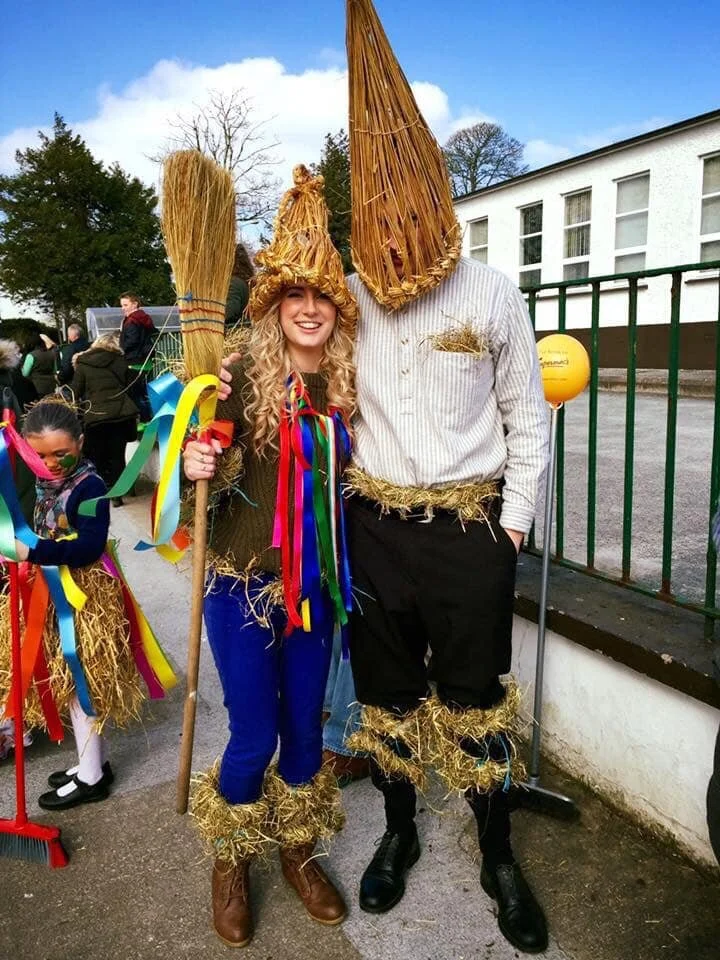It's Mummers' Season
Caps, wigs, net curtains, aprons, tea towels, wellingtons, straw, meal bags, women’s underwear and masks, ribboned with jigs, reels, hornpipes, storytelling and dance, interspersed with the antics of the mummer king. They’re my first memories of those colourful people that brought such revelry to the Christmas household; the mummers.
I didn’t know what to make of them as a child. It was a whirlwind of madness when they entered your house, like you’d fallen right into a scene in a Roald Dahl book. There wasn’t a serious word to be spoken and their rhymes made no sense to me at all. But they certainly brought fun and devilment with them. And even though I never knew who those people were behind the masks, they seemed to know a lot about me and my family. However, I did notice that the mummer playing the fiddle wore the same boots and had the same long fingers as my grandfather, Ned, who also happened to play the fiddle. Coincidently, I met Santa on a few occasions in my youth and he too wore the same boots as this fiddling mummer.
I recently travelled to Newfoundland, Canada to study the similarities between our dancing traditions and in every tourist shop I stepped into, I was met with pictures and figurines of mummers. I didn’t know this tradition existed in Canada until I spoke to some of the elderly people of Renews and Fogo Island who spoke of many happy memories of Christmas kitchen parties with the mummers. Indeed, most of them were mummers themselves. A tradition that was brought to Newfoundland by their Irish ancestors and one that is still very much alive out there. It was on hearing all these great memories from people across the Atlantic that a small sadness grew in me for that very tradition that is almost lost, back at home in Ireland. It also reignited a dormant appreciation and pride in me for the mummers and I thought to myself, sure maybe if more people knew about it, they might organise their own groups over Christmas and spread some joy amongst their communities.
So, I’m here to tell you all about the mummers in the hope you might apply for the job!
Mummering is a beautiful, old Irish Christmas time, house visiting tradition involving a group of friends or family who dress in disguise and visit homes of their neighbours & community during the twelve days of Christmas. If the mummers are welcomed into a house, they will sing, dance, play music and tell stories and perform the mummers’ play. The hosts must guess the mummers’ identities before offering them food or drink. They may poke and prod the mummers or ask them questions. To make this a challenge for the hosts, the mummers may stuff their costumes, cross-dress, wear silly disguises and adjust the tone of their voices. Once the mummers have been identified, they remove their disguises, spend some time with the hosts, before they travel as a group to the next home.
Now don’t get confused! Strawboys are for entertaining all year round at weddings and wakes, Wrenboys are for hunting the Wren on St. Stephen’s Day while traditionally, the mummers marched and performed during the twelve days of Christmas. They were led by a captain or king and they would sing, dance, play music and act the fool upon his request.
By the Mummers’ Rule, the lads were obliged to act decorously and visit every house in the vicinity, Catholic or Protestant, rich or poor, friendly or not. Their Captain knocked at the door, courteously requesting admittance. It was Christmas time, when nights are long and cold. The mummers huddled on the street, in the deep dark and icy winds, deciding whether to compress their performance into a “wee quickie” or drive it to the limit and “go in with a vengeance.” - (From “All Silver and no Brass” by Henry Glassie)
The Mummers’ play was their piece de resistance. It was probably the scene of the first folk theatre in Ireland. Generally, the mummers’ play was in verse and usually the main theme was a battle between two heroes, there was a death and a miraculous resurrection by a doctor and none of it was taken too seriously. The play brings to life characters such as St. Patrick and his battle with St. George, Oliver Cromwell, Jack Straw, Beelzebub and the Doctor with his bag of cures and tricks. Amidst the dancing, music and comedy were the universal themes of good triumphing over evil and marking the year’s passing with a reflection on the death of the old year and the rebirth of the sun for the new year.
While the origins of mumming aren’t known, it is an ancient tradition in our homeland, said to date back as far as 2500 years. There is reference to them in the ancient annals of Ulster, men in disguise and tall conical masks are mentioned as chief entertainers to Conor Mac Nessa, King of Ulster, at the fort of Emain Macha.
This Christmas, at Áirc Damhsa Dance Club, the children are visiting several hospitals and nursing homes across 7 counties, as the mummers. It’s a simple thing to do and brings great joy and memories to all. So out you go and follow in the footsteps of your ancestors. Get your friends and family together, dress up in disguise and gift your neighbours and community with a story, a song, a tune or a dance and share some of the ancient magic of the mummers.
Beannachtaí na Nollag
Edwina



